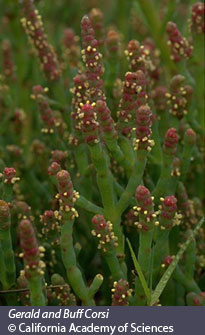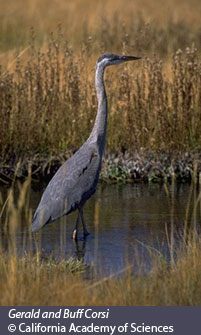LOCATION:An estuary is an area where seawater mixes with freshwater. Estuaries can be found along
the coast. Each day as the tide rises, saltwater is brought into the estuary. Freshwater
comes down the rivers and creeks and mixes with this saltwater. During the dry season there may not
be much freshwater flowing down the rivers. This can make the estuary very salty. Also,
during the dry season water evaporates out of the estuary making it even more salty. If
you have ever tasted the water in the ocean, you know it is very salty. Estuaries can become
even saltier! (But don’t try tasting the water, not only will it taste bad, but it
can be bad for your health.)
 PLANTS: Plants found in estuaries need to be adapted to salty conditions. Having too much salt can
kill many types of plants. Some plants, like pickle weed, can absorb the salt water and
store the salt in special compartments, called vacuoles, in the leaves. This makes the plant
taste very salty which may be one of the reasons it is called pickle weed. Can you see the
other reason in this picture? Other plants, like salt grass and alkali heath, are able
to push the salt out onto the surface of the leaves. The salt crystals can be seen if you
look very closely.
PLANTS: Plants found in estuaries need to be adapted to salty conditions. Having too much salt can
kill many types of plants. Some plants, like pickle weed, can absorb the salt water and
store the salt in special compartments, called vacuoles, in the leaves. This makes the plant
taste very salty which may be one of the reasons it is called pickle weed. Can you see the
other reason in this picture? Other plants, like salt grass and alkali heath, are able
to push the salt out onto the surface of the leaves. The salt crystals can be seen if you
look very closely.
ANIMALS: Many types of animals are found in estuaries.
In fact, the complex food web found in an estuary helps to support an amazing diversity
of animals. The decaying plants are eaten by microorganisms (animals so tiny you need a
microscope to see them.) The microorganisms are eaten by small invertebrates (animals without
backbones.) Fish, like carp and stickleback, then eat the invertebrates. Many of the fish
we eat depend upon estuaries. They are sheltered places where fish can have their young
and the young fish can grow before moving out into the open ocean. Without estuaries, the
number of fish in our oceans would decrease greatly. Occasionally, water in certain areas
of the estuary can dry up and all that is left is a mud flat. It may seem like there is
no life in this mud flat at all, but there are all kinds of mussels, shrimp, worms and other
invertebrates living in the mud. Often you can see birds probing the mud with their beaks
looking for a tasty meal.
 There are a large number of birds found in estuaries. The migrating birds such as geese use them to rest and feed. There are also birds who are permanent residents of the estuaries. Many of these birds, such as the Great Blue Heron, and the Great Egret, have long legs that they use for wading in the water. Egrets are excellent at hunting fish. Some wiggle their toes in the sand to attract fish, which they can snap up for a meal. If you look at the different types of birds, you will notice that they all have different lengths of bills. This means that each type of bird is adapted to eating different things. This reduces the amount of direct competition between the birds and allows more types of birds to live in the same area.
There are a large number of birds found in estuaries. The migrating birds such as geese use them to rest and feed. There are also birds who are permanent residents of the estuaries. Many of these birds, such as the Great Blue Heron, and the Great Egret, have long legs that they use for wading in the water. Egrets are excellent at hunting fish. Some wiggle their toes in the sand to attract fish, which they can snap up for a meal. If you look at the different types of birds, you will notice that they all have different lengths of bills. This means that each type of bird is adapted to eating different things. This reduces the amount of direct competition between the birds and allows more types of birds to live in the same area.
People and Estuaries: Everyone wants
to live near the ocean, right? Unfortunately, in order to build houses near the ocean, estuaries were
drained and filled in with dirt so that houses could be built on top of them. Many of our estuaries
were destroyed before people realized their value.
Estuaries are valuable for a number of reasons. Many countries and coastal
communities around the world rely mainly on fish as their primary source of protein. Estuaries help
maintain fish populations in the ocean, and without them we would have fewer fish to eat. Estuaries
are also natural water filters. They filter the river water that flows into them, helping to keep
our ocean water clean and safe for everyone to enjoy. Another important service they provide is
protection from large storms and hurricanes. Large waves caused by these storms can cause incredible
amounts of damage when they come onshore. Estuaries create a natural barrier that absorbs the
energy of the waves and prevents them from flooding cities, destroying houses and injuring people.
GAME:
Water Life: Where Rivers Meet the Sea
LINKS:
Estuaries.gov
National Estuarine Research Reserve System
EPA: Exploring Estuaries
EPA: National Estuary Program
Discovery of Estuarine Environments
Office of Naval Research - Ocean Habitats
Restore America's Estuaries
Natural History of Nova Scotia - Tidal Marsh
Back to Biomes Index

